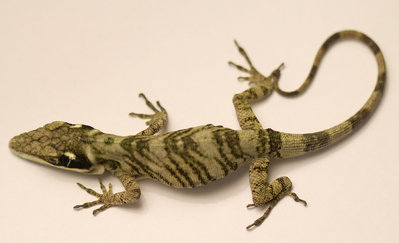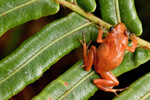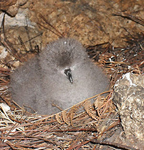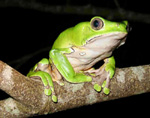Long-Lost Lizard Found, Sacrificed for DNA
By Dady Chery
Haiti Chery
More frog species live in Haiti than anywhere else in the Caribbean. This great variety partly resulted from the isolation of animal populations by the mountainous landscape. Many species of the small lizard anole also make Haiti their home. These animals have attracted the attention of well-meaning conservationists as well as soulless seekers of fame.
At the end of July 2011, an expeditionary team withdrew over 100 animals from an isolated patch of virgin forest in the mountains of Haiti’s Tiburon peninsula. It was led by Pennsylvania State University biologist Blair Hedges, who brought along one of his graduate students, Philadelphia journalist Faye Flam, Dominican free-lance photographer-naturalist Miguel Landestoy, a videographer, and a botanist with some knowledge of Haitian Kreyol.[1]
The group was flown by helicopter to a remote Haitian forest at an altitude of about 1800 meters where they removed as many lizards and frogs as they could find from a chilly patch of woods that the animals had made their sanctuary.
The journalist reports that:
“Near the end of the trip, the team began searching in a region that was lower and much hotter, and the blistering sun was threatening the whole collection of rare frogs and lizards. With my own skin beginning to burn, I volunteered to take the more than 100 animals back by helicopter to the island of La Vache, off the south coast of Haiti, where there was an air conditioned hotel room waiting for them. These high-altitude creatures are adapted to cool temperatures and can die if exposed to more than a minute or so of harsh daytime sun….
“Though some will inevitably die, the goal was to get them through the trip and back to Pennsylvania alive, where they can be studied and catalogued. Every time I checked, the frogs and lizards were stirring. By luck, most got through the night, and are now in Port-au-Prince awaiting their first and only trip to the United States!”
What sorts of scientists would show up for a project like this without a cooler, and then abandon their samples of rare and endangered animals to the heat, or to a journalist, casually expecting some of the animals to die?
Take a peek at this video of the expedition:
Returning to our expedition. Suppose a group of Haitians were to decide to go, say, on a helicopter trip to the Ozark Mountains to collect endangered animals because the Ozarks were being destroyed by mountaintop removal. And let us suppose further that this group of Haitians bagged 100 animals or so — all rare, some never before reported, others nearly extinct — and tried to fly them all to Haiti. What do you think would happen?
It turns out that 27 years ago, the same scientist who headed the Penn State team had removed the identical species of lizard from another region of Haiti. Anolis darlingtoni has not been seen there since. Here is how Hedges got his previous quarry and what happened to it [3]:
“…we collected on the slopes of the Massif de la Hotte south of Castillon. On the evenings of the 5th and 9th of November [1984], at an elevation of 1360 m, we found Anolis darlingtoni in a one-hectare patch of disturbed forest….sleeping on vegetation about 1-4 m above the ground. Three juveniles (two were collected) were found sleeping vertically on the tips of dead tree fern branches (l-4 m high) while three adults were found sleeping horizontally on limbs of small trees low (1 m) to the ground.
“Two of the three adults (all males) were deposited in the United States National Museum and the third (skeletonized) was deposited in the Museum of Comparative Zoology. The two juveniles were used in biochemical analyses and are in the frozen tissue collection of the junior author.
In other words, all the collected animals were killed, although before that expedition the animals were considered extinct and had not been seen for 50 years.[4]
About the current expedition, the journalist writes further:
“Hedges estimates they’ve picked up about 33 unique species here – several of them never seen before – living proof that if deforestation doesn’t stop in Haiti, we will never know the full extent of the country’s loss.”
Sounds kind of noble, doesn’t it?
In addition to Anolis darlingtoni, rare animals noted in the video include:
- La Hotte glanded frog (Eleutherodactylus glandulifer),
- Mozart’s frog (Eleutherodactylus amadeus),
- The Hispaniolan lesser racer snake (Hypsirhynchus -Antillophis- parvifrons), and
- The Macaya dusky frog (Eleutherodactylus ventrilineatus, exceptionally rare)
Wouldn’t it be better to help stop Haiti’s loss instead of merely monitoring it? Had these scientists felt any motivation to stem this loss, the logical next step would have been to collect extensive videotape footage of the animals in their natural habitat, leave the animals alone, and use the videos to advocate for official protection of the mountain sanctuary on their behalf. But this is not what these scientists did.
Instead, they took the animals to a laboratory at Penn State to be ground up and studied. Here’s how they justified these actions in the video:
“Bringing specimens to the lab is critical for several reasons. DNA sequences are needed for correct identifications. Morphological analyses are needed to describe new species, and cryo-banked cells will keep species alive in case they go extinct in the wild.”
In other words, Hedges is claiming that it is necessary to bring an animal to the lab to examine it carefully, to kill the animal and extract its DNA to identify it correctly, and to freeze its cells to “keep [the] species alive.” This is quite misleading, of course. A far superior way to preserve an animal’s genetic material is by treating him with respect and letting him live out his sexual life. In any case, the same species had already been frozen in 1984, and such deep-frozen specimens should last indefinitely. And so there was no conceivable scientific justification for removing the endangered lizard seen in the video.
A bit later, the video notes, in the continuing calm tone of the readers of devastating side effects of drugs in U.S. television advertisements, that the Macaya dusky frog was
“later found to be genetically distinct from the Macaya populations.”
Meaning that the little frog that we saw being manhandled in the video (around minute 10) is quite dead now too, and its DNA has been extracted and studied.
Hedges is not the only westerner who has chased after Haitian frogs and lizards. Other collectors of these animals have claimed that they were meant for captive-breeding programs, but I have yet to find such a program. In fact, some of these people could be adventurers who trade in endangered animals or fools who try to keep the animals as pets.
Whatever the motives of this Penn State team, one thing we know for sure is that the animals collected on this expedition were endangered animals and possibly the last individuals of their kind.
Yes, deforestation is advancing in Haiti. I make no excuses for us Haitians in this regard, though I do feel obliged to note that the world loses 16 million acres of forest each year, and deforestation is a problem for the entire globe, including the U.S. [5]
The Haitian frogs and lizards were hunted in their forest sanctuary: one requiring a tortuous journey by helicopter and picked for its inaccessibility to humans. The animals were spirited away to a U.S. laboratory to be ground up and exploited.
Such comportment by scientists is criminal and would be illegal in the United States. It brings to mind the christian missionaries who kidnapped 33 Haitian children immediately after the earthquake. Like the missionaries, these U.S. scientists feel that while in Haiti they are under no legal or ethical guidelines. In fact they were so proud of their deeds that they publicized them in an article[1] and a video.
Obviously, their overarching interest is to publish scientific papers that move their careers along. But DNA sequencing, which is what these scientists evidently do best, is actually quite boring and undemanding. Scientific papers on DNA sequencing do not make careers, unless one sequences the DNA of the cholera that infected Haiti or something of the sort. In other words, if the owner of the DNA is exciting, then one can instantly turn an otherwise boring sequencing project into a “hot” career-building enterprise.
As it happens, lizards are a hot scientific topic right now. The first genome (all the DNA that makes up the genetic material) sequence for a reptile was published three months ago, and it was the sequence of the green anole (Anolis carolinensis) genome.[2] The justification offered by a team at Harvard for this project was that there was a connection to human health because of
“the anole split brain and the fact that female anoles alternate ovaries in producing eggs, just like one other group of vertebrates.”
The project resulted in a huge grant to the Harvard group, which had searched Haiti’s Tiburon peninsula for Anolis darlingtoni in summer 2009 and failed to find it. And so this summer’s expedition to the peninsula by a rival Penn State team to rediscover this elusive animal might have been motivated merely by a desire for one-upmanship.
Scientific research and competition are well and good, but the U.S. scientific establishment ought to pay more attention to the ways scientists are collecting their biological materials for genome sequencing projects these days.
Back in the late 19th century, the likes of Charles Darwin and Alfred Wallace, and leagues of lesser-known scientists and adventurers, undertook long voyages after which they returned from the New World with boatloads of animals preserved by pickling or taxidermy for stocking the British natural history museums. The sale of rare beetles was so lucrative that many people made their living from it, and the stocks of the animals collected in those times were so vast that, even after more than 140 years, only a minor fraction have ever been exhibited. We, of more enlightened times have, of course, come to consider this mode of study as being no longer an acceptable way to treat animals.
Have you ever wondered how many species of birds and beetles the 19th-century scientist adventurers eradicated? I have.
In a sort of scientific neocolonialism, we find a 21st-century group from the U.S. casually removing and destroying rare animals from places they consider to be their backyard.
The video’s concluding remark is:
“Without protection, they will all disappear soon.”
Without protection against whom?
UPDATE #1, December 2, 2011. I just learned from a reader (Kate of DFW Wildlife Coalition) that you can lodge a complaint about this action to NSF and NASA, which finance this scientist’s animal research. Contact:
http://www.hq.nasa.gov/office/oig/hq/hotline.html
http://www.nsf.gov/oig/hotline.jsp
UPDATE #2, December 14, 2011. This case of the destruction of endangered lizard and frogs might take months to get resolved, but it was brought to the attention of the agencies that finance the research and is being pursued. I will keep you updated as I learn about the developments.
UPDATE #3, July 2012. The U.S. government has investigated the matter and concluded that there was no evidence of wrongdoing, despite these scientists’ published description of killing several endangered animals and the videotape of their foray into Haiti.
References:
1. Penn State team finds a long-lost lizard in Haiti
http://www.philly.com/philly/blogs/evolution/A-Long-Lost-Lizard-is-Found-in-Haiti.html [Correction: The article previously stated that “The team included no Haitians”, but since this publication, I’ve been informed that there was one Haitian collaborator. DC]
2. How the green anole was selected to be the first reptile genome sequenced
http://anoleannals.wordpress.com/2011/08/31/how-the-green-anole-was-selected-to-be-the-first-reptile-genome-sequenced/
3. Caribbean Journal of Science, Vol. 27, No. 1-2, 90-93, 1991.
4. A Day of Highs and Lows in Haiti
http://treethinkers.blogspot.com/2009/08/day-of-highs-and-lows-in-haiti.html
5. Global deforestation.
http://www.globalchange.umich.edu/globalchange2/current/lectures/deforest/deforest.html
Sources: Haiti Chery | Black Agenda Report | Synthesis/Regeneration Magazine, vol. 59
Read additional comments about this article, at our contact page.











There are no words to describe my utter disgust to all of this. Seriously, the Haitian government’s inaction on the matter is not only unacceptable, it’s pathetic. Greed is driving the world into chaos. Really sad that children from the next generation might end up being clueless about the beauty of Haiti’s natural landscape.
Thierry, I totally agree with everything you wrote.
Haiti’s wild places are breathtaking! There is so much to lose.
If the government won’t do anything to protect the country’s biological heritage, then regular people might. Please spread the word about these news, especially if they might eventually reach the ears of people who work at the airport in Port-au-Prince. This is very important.
Another thing we can do is complain to U.S. agencies (the National Institutes of Health and National Science Foundation) about the unethical behaviors of researchers they are financing. I will write again in the next day or two with suggestions on how to do this.
Just wanted to point out several factual errors in your article. The expedition team described in your article did include a Haitian and was supported by a leading conservation group in Haiti. It has the backing of the Ministry of Agriculture which issues the permits necessary to collect live specimens for scientific research and captive breeding at the Philadelphia Zoo. Coolers are taken to the field and the animals are handled and transported professionally. The phylogenetic studies, as conducted by Blair Hedges, are especially necessary to determine the biodiversity of Haiti and advance conservation biology. The data supports the Systeme National d’Aires Protegees (Ministry of Environment) by identifying threatened species (especially those only found in Haiti) and their habitats that require protection for them to survive.
It is indeed shameful that there exist Haitians who collaborate with the occupation and its “Vichy” in countless ways, but there have been such people in every occupation. As is evident from the comments (see here and the contact page), the readers of the article realize that the actions of this group had to have been sanctioned by Haitian collaborators and are most outraged by this. The participation of the occupation government does not establish the legitimacy of the expedition but rather the illegitimacy of the government. An occupation government functions to permit tresspasses by the occupiers, whether this is collecting and killing citizens (by MINUSTAH) or endangered lizards and frogs (by US scientists). I will amend the article to point out that a Haitian collaborator participated in the expedition. If the endangered amphibians and reptiles had been in coolers, this is not shown in the video posted by the authors themselves. The animals are shown plastic bags (around minute 11 in the video), and the abuse is reported by the journalist who accompanied the expedition. Since your video also states that the specimens have been used for various analyses (meaning that they were killed), the Philadelphia Zoo should have some difficulty with their captive breeding program.